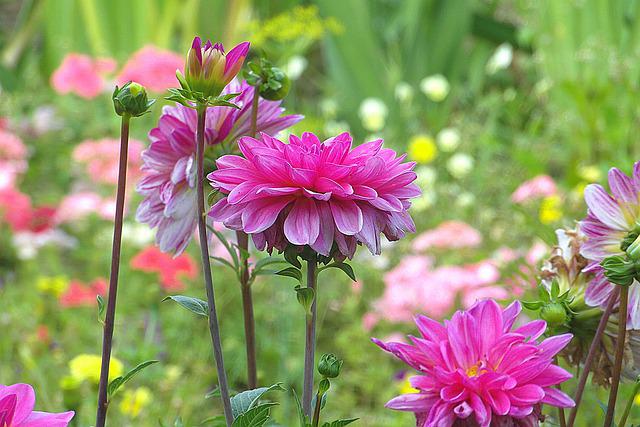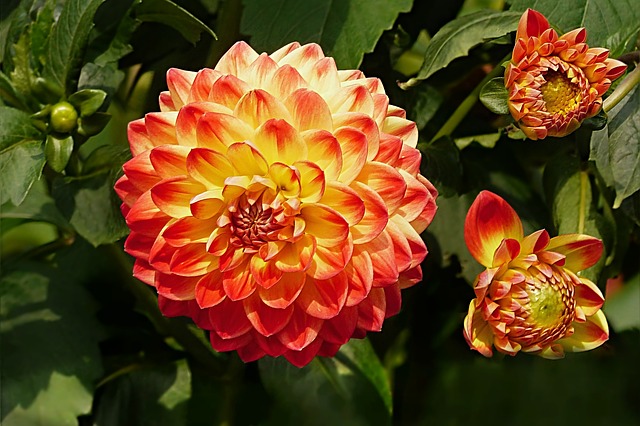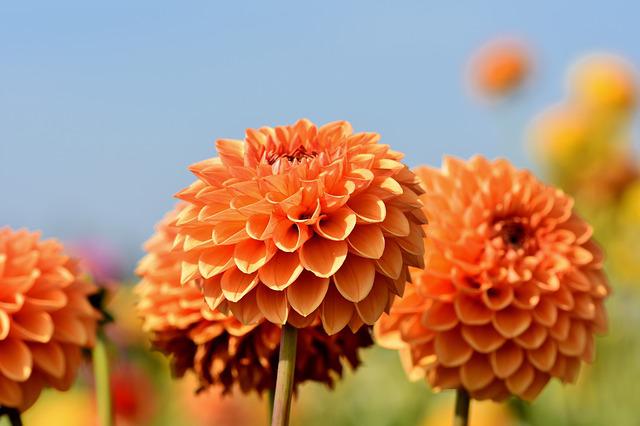Dahlia Temperature Tolerance: How High and Low Can You Go?

The ideal daily average growing temperature for dahlia is between 68-72°F (20-22°C). A minimum nighttime temperature of 60°-64°F (15°-17°C) is required. Higher daytime or nighttime temperatures will hasten the flowering process, but prolonged exposure to higher temperatures can diminish plant quality. Avoid temperatures above 80° (27°Celsius). Reducing the nighttime temperature to 55°F (13°C) makes it possible to delay the harvest as the selling season approaches.
Table of Contents
6 Interesting Facts About Dahlia on Temperature Tolerance
As Counterintuitive as It May Seem, Dahlias Thrive and Develop Rapidly in Dim Light
The scientific rationale is that when it gets dark, plant phytochromes sense the lack of light and signal the plant to respond by sending out more growth hormones and stretching out its body. Using the glucose stored during photosynthesis, the most rapid expansion is seen just before sunrise. Food for cell production is created from nutrients. This is why the hours before sunrise are ideal for cultivating dahlias.
Heat Kills Dahlias at 90°F (32.2°C )
When temperatures are too high, dahlias may not bloom. Don’t lose hope if your dahlias don’t seem to be flowering. When the temperature drops, they will bloom. Keep an eye out for things like distorted blooms and an increased propensity for pests and diseases as stress indicators. When you start feeling the effects of stress, don’t give up. The plants must be fertilized with an organic fertilizer that contains little to no nitrogen.
Dahlia Likes Warm Climates
We recommend certain heat-tolerant dahlia varieties for growers in warmer regions. As a result of participating in gardening and other forms of cultivation, we can all expand our horizons and develop personally and intellectually.
Frost-Resistance
Although dahlias’ foliage will perish in temperatures as low as 32°F (0°C), the tubers will remain unharmed. Plants and tubers will perish in temperatures as low as 28°F (-2°C). The ideal temperature range for storing tubers over the winter is between 45-50°F (7-10°C). Frost kills the foliage of dahlias, and their roots are only hardy to about 15°F (-9°C).
Planting
It is best to plant the tubers as soon as they arrive. If you can’t do that, store tuberous roots between 45-50°F (7°C-10°C). When planting tubers, it’s important to ensure the top of the plant is above the soil and even with the edge of the pot. If you bury it, the number of shots may be less, and they may come later. For the first 5 or 6 weeks, the plants should be close together in the pot. After that, they should be spread out. After planting, give the soil a lot of water. Keep the soil moist but not soaked until the shoots start to grow quickly (4-5 weeks).
Sowing Dahlia Seeds
Dahlias are usually grown from tubers because it is faster and usually more reliable, but it is possible to grow them from seeds.
The best time to plant dahlia seeds is between February and April. Sow seeds 0.5 cm deep in moist compost in trays. Set somewhere warm, between 60 and 68°F (about 15-20°C). Keep moist.
When the seedlings are big enough to handle, move them to deeper trays or small pots. Grow on in places that are cooler but don’t get frost. Before planting young plants outside in May or June, when there is no longer a chance of frost, let them slowly get used to the cold.
Guide to Growing Dahlias in the Summer

Most Plants Do Best in Full Sun
The most important thing to remember when growing Dahlias in the summer is that they need plenty of sun. If you live in a partial shade area, place your plants near a window where they can receive direct sunlight. Or grow them outdoors in full sun if possible.
Water Regularly Soil Is Moist and Well Drained
Avoid keeping your dahlia plant-soil too dry. Instead, keep it moist but not soggy by watering regularly. Do not water during the hottest part of the day, as this will cause your plant to wilt.
Plant Dahlia Varieties That Can Withstand the Heat
All dahlias can handle some heat, but some varieties do better in certain climates. For example, Senior Ball, Show N Tell, and Winkie Colonel need a lot of direct sunlight to bloom well. If you live in a climate with hot summers, choose varieties like ‘Blushing Bride,’ which needs afternoon shade but blooms all day long under the right conditions.
Planting Season
Growers of dahlias typically suggest a September planting date for areas in hardiness zones 9 and 10, where winters are typically frost-free. Over the summer, keep the tubers you get in the spring (or divide in the spring) in a cool, dry place indoors. Tubers should be stored same way as during the winter: moist and cool.
If you plant dahlia tubers in the fall, you can expect to see flowers in November and December. Plants typically start to turn yellow in late December or early January. When this occurs, cut them down to the ground and cover the cut area with compost. Second flowering from the tubers occurs in April and May after new growth emerges in February. When summertime temperatures rise, it’s time to prune the garden back to the soil. You should divide your tubers now; doing so is necessary every two to three years. A layer of water-permeable mulch (such as pine straw) spread over the plants is an effective way to keep weeds at bay if you plan on leaving the plants in the ground. Don’t worry about the plants again until the fall, when the cycle resumes.
Protecting Dahlias from the Heat
As a result of climate change, gardeners now face a wide range of previously unanticipated difficulties, from unusually severe weather to pests and diseases that have never before been seen. Growing dahlias may be more challenging in regions where summer temperatures are rising. Lucky for us, dahlia enthusiasts in the southern states have years of experience cultivating stunning dahlias in scorching temperatures. Follow the link for a list of heat-resistant dahlia varieties and some of their gardening advice.
Give the Soil Plenty of Organic Matter and Good Drainage
Dahlias grow best in loose, crumbly, and rich soil. Add compost, shredded leaves, or rotten mature to the planting area at the beginning or end of each growing season. Soil that is loose and full of humus helps roots grow strong. It also soaks up and keeps water so that your plants can use it when they need it.
Places that get a lot of rain in the summer need soil that drains well. The roots of dahlias can’t breathe in wet soil, which stops them from growing well and can cause the tubers to rot. If your yard’s soil is heavy and doesn’t drain well, or if it rains a lot, you might want to grow your dahlias in raised beds. The beds should be as deep as possible. 10-12″ sides are ideal. Filling these beds with a mixture of compost and a growing medium without soil will ensure they drain well.
Mulch for Soil Cooling
The ideal planting depth is the same as in any other climate. The eyes or sprouts of the tuber should be facing upward, so make sure to dig a deep enough hole. About an inch of soil should be left above the level of the eyes or sprouts after planting.
Dahlias have feeder roots that are shallow and can extend up to 18 inches in all directions from the soil surface. When applied as a thick layer over the soil, mulch can insulate the roots and shield them from the sun’s intense heat. Mulch should not be any thicker than 3 inches and should let water penetrate the soil. Early July is ideal for mulching because that is when your plants are at their strongest, and it is still not too hot.
Make Use of a Shade Structure
Investing in a shade structure is recommended if you want to grow many dahlias in a hot, sunny climate. It’s a great option for backyards with no trees to provide shade. Shade cloth made from UV-resistant polyethylene can be used for years without fading and can block anywhere from 20% to 80% of the sun’s rays. The ideal amount of shade for dahlias may be around 30 percent.
For Dahlias, Warm Is Best, Not Hot
Dahlias develop in a particular region with its biome. They originated in the mountainous regions of southern Mexico and Central America, where the summer days are hot (80-85 degrees Fahrenheit) but the nights are cool (65-70 degrees Fahrenheit). Conditions for growing dahlias are similar to those in the Pacific Northwest. Growing dahlias requires extra forethought and care in regions with warmer or more extreme temperature fluctuations.
Dahlias Benefit From a Misting on Hot Days
Some Florida and Australian dahlia growers use water to cool their plants on hot days. The plant life can be sprayed once or twice daily with a misting system or a simple watering wand. The increased humidity reduces the heat load on the plants.
Plants Need Nutrients To Thrive
Hotter climates are hard on dahlias, so it’s important to ensure they get the nutrients they need to thrive. Plants that lack sufficient nutrition have a more challenging time surviving and thriving. Implement a 5-5-5 fertilizer at planting time per the instructions on the package. An additional strategy is to use a slow-release fertilizer like Osmocote.
Dahlias require a lot of food to thrive. Water-soluble fertilizer applied once a month is recommended, even in fertile soil. Fertilize your plants once they reach a height of 6-12 inches. Feed them up to once every two weeks once they start to bloom. The best fertilizer to use on your roses or tomatoes is one that dissolves easily in water.

